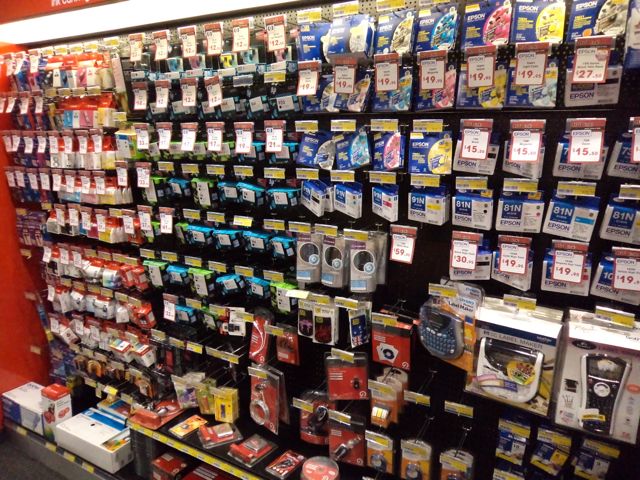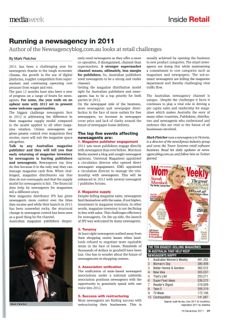First up I should note that there is no right way to do a magazine relay. What I am publishing here is my opinion. It’s worked for me in several of my newsagencies. It may not work for all.
Next I need to say that this is not an end game. The relay you do will not be your last. A good magazine department is like a field in a farm – It needs tending and each a year it needs replanting. (Sorry to the farmers if my analogy is off.)
Finally I would acknowledge that I obsess about magazines. (You should too.) Some might say I am obsessive compulsive. Magazines, or rather the range of magazines we have, represent the single most important point of difference we have over any other retailer in Australia. For the medium term – maybe three years out – we can leverage that for traffic and sales growth.
Okay, that said, on to the relay…
PLANNING
Before doing anything think about your customers and how they shop. Watch them, where in the magazine department they head first, where they congregate and how they interact with what you sell.
While you do this over a few days, print off a report looking at your magazine sales, preferably by MPA category – comparing that last three months with the same three months a year earlier.
Look at the percentage of sales delivered by each category and look at sales trends for the categories. Tote up broad groups. For example the percentage of sales for women’s weeklies, women’s interests, crafts & hobbies, crosswords, home & lifestyle and food & wine. If your newsagency is like mike, this grouping will account for more than 50% of your magazine sales.
If you then add up motoring, men’s lifestyle, sports & leisure, music & entertainment (possibly) and buying & selling and you have your men’s titles – probably around 30% of sales.
Think about the data you have collected and what you have observed in the business. Talk about this with your staff. Discuss ideas for better placement of magazines.
WHAT TO CONSIDER IN A MAGAZINE RELAY
The goal of the relay has to be an increase in sales. It’s business after all. The easiest way to drive sales is to give shoppers what they want and to make it easy for them to find, interact with and purchase what they want.
Forget everything about your current magazine layout. Yu really need to start with a clean slate.
Think about what people are likely to purchase with other titles. This often leads to debate. Go into this knowing that what you think people buy with other titles is often not reflected in your sales data.
I like to create zones which reflect the genders and interests. I start by creating a women’s shopping zone, an or a location aisle they own, where they are comfortable. This is in the best position in the magazine department, easy to access, easy to shop.
Thinking about the magazine department in terms of zones makes approaching the relay easier I have found.
I see the women’s zone as having women’s weeklies, women’s interests, home & lifestyle, crafts & hobbies (not all hobbies but certainly cross-stich, card making, knitting etc), gardening, crosswords, bridal, hair, pregnancy and women’s health and fitness. Now this depends on the space you have available.
The men’s zone has the men’s title categories noted above.
You also need a zone for tech titles for computer, gadget and gamer magazines. This should be next to a zone for photography titles.
I tend to prefer to see the ACP cookbooks in a zone of their own where you can show off the range and appropriately support new titles which come out monthly.
I try and find a separate location for current affairs, business and allied titles. This often is next to hobbies like railway or air titles.
There is bound to be internal debate for you or external debate with others about what you put into your zones. Don’t worry too much since this is not an end game and it would not take long to make changes as you go.
NOW, THE MAGAZINE RELAY
My preference is to do this alone as it allows me to make changes as I go based on what I see.
Take every magazine off the shelves. That’s right. If you are going to do this you have to commit and taking every magazine off the shelves is a commitment. Also, take down all magazine posters.
Clean the shelves. What an opportunity.
Now start building the women’s zone. From the busiest section in. If it is an aisle, start with women’s weeklies on one side and fashion (marie claire, Cleo, Cosmo, Vogue) on the other. But concentrate on one side first, the weeklies. Respect your top sellers, give New Idea, Women’s Day, Famous, NW, Who, OK!, That’s Life and Take 5 prime position. Keep a pocket for TV Week. Use between three and five pockets for some Lovatts crossword titles.
Next to the weeklies I’d then place, in order, a waterfall of Australian Women’s Weekly, British women’s magazines (yes, all of them), country living titles, Better Homes and Gardens in a waterfall, home and living titles, food, wedding with a waterfall of the major title currently in and hair. For me that sees out one side of the aisle. This is where you need to think it through in terms of the space you have.
On the opposite side, directly across from and facing women’s weeklies, I have fashion young, fashion older and I end this with a waterfall of Frankie. Next is women’s health starting with younger target titles and blending to older ones. Next is pregnancy and baby followed by crosswords. This usually rounds out that side.
This is my women’s aisle.
You can see that I am using key titles as borders and features at the same time.
I look for one space on each side for an in-location display, where I take between four and six pockets for a poster supporting a title. This can help ease the visual conflict of a mass of titles and drive incremental business for a good title to boot.
I hope that people understand my approach. What I do in women’s is the same for the other zones I create. I do each zone separately and try and get into the head space of the shopper of the zone – using the most popular titles to act as beacons, or signposts, for the zone.
I also take note of covers and give really good covers, eye catching covers, time in the spotlight.
I am careful what I place next to top selling titles. This is a prime spot, next to the popular titles. Choose wisely. Choose titles that naturally fit next to the big titles, titles shoppers are likely to browse and purchase on impulse.
If I am not sure about where to put a title I put it aside and move on.
I take extra time with special interest and hobby titles. For example, I put railways and model railroad titles near each other but I am careful to ensure that they are separated as they appeal to two shoppers and only occasionally do you see titles from both segments in the same basket.
Within the zones I look for and respect specialisation. For example, within men’s lifestyle and sports I create a clean space for the quality serious fitness titles like Coach, Men’s Health and Men’s Fitness. I am sure to separate these from Maxim and some other the other similar titles which can be in this section.
While I could go on and list all titles adjacencies I run with, I hope that the explanation above is sufficient to set you off on what is right for your business.
By the end of a relay you will be exhausted but in a good way. You will have something new and fresh for your customers to explore, something you created for yourself and your business. Something of which you can be proud. What you have will be your IP, your magazine specialist knowledge encoded in your magazine department. Your point of difference will be on show … how good is that?!
REVIEW, FEEDBACK, FOLLOW UP
You’re not done when you think you are done. Track your sales, listen to your team and your customers. Tweak where you feel it is necessary.
Bring new issues to the fore. Continue to be engaged in how your magazine department looks.
I did my last complete relay in one of my newsagencies in September and have moved three zones since then. Every week I spend considerable time in the magazine department, looking for opportunities with which I can reflect our point of difference better.
Continue to look at your sales data. If there is no lift them be open to having made choices which are not right for your business. Be prepared to do it all again.
FINAL WORDS
Doing a magazine relay can be like doing one of those kid’s puzzles – you move them around and around until you have the completed image. That image can look and feel like a work of art once you are done.
I can’t stress enough the importance and value of a magazine relay to your business and you personally. This is you placing your stamp on the business. It is you breaking free from being a conveyer belt newsagent. It is you taking ownership of your business.
If you have made it this far, thanks for reading. Magazines really are a point of difference which we need to work harder at embracing – despite the challenges of the distribution system.
I’d be happy to answer questions or discuss magazine relays with anyone: mark@towersystems.com.au or 0418 321 338.
Over to you…
Click here to download this blog post as a document.
 Newsagents are often frustrated that their businesses are regarded as expensive. One way to combat this is to educate your staff about the price difference between key products in your newsagency and nearby competitors like Officeworks, stationery shops, supermarkets and convenience stores.
Newsagents are often frustrated that their businesses are regarded as expensive. One way to combat this is to educate your staff about the price difference between key products in your newsagency and nearby competitors like Officeworks, stationery shops, supermarkets and convenience stores.
